The Effect of the Korean Hot Spot in the Cold War (1950-1953)
VerifiedAdded on 2022/10/11
|5
|1044
|7
Essay
AI Summary
This essay delves into the Korean War, analyzing its significance as a critical hotspot within the broader context of the Cold War. It explores the conflict's origins, tracing the involvement of major powers such as the United States, the Soviet Union, and China, and examines the motivations behind their interventions. The essay investigates the war's objectives, the strategies employed, and the resulting impact on the Korean peninsula and the global political landscape. It examines the roles of North and South Korea, the devastating consequences including loss of life and economic disruption, and the lasting effects of the armistice agreement. Furthermore, the essay reviews relevant literature, employing theories to understand the conflict, and outlines the research methodology used, including the use of questionnaires for data collection and analysis. The study aims to provide a comprehensive understanding of the Korean War's role in the Cold War and its enduring legacy.
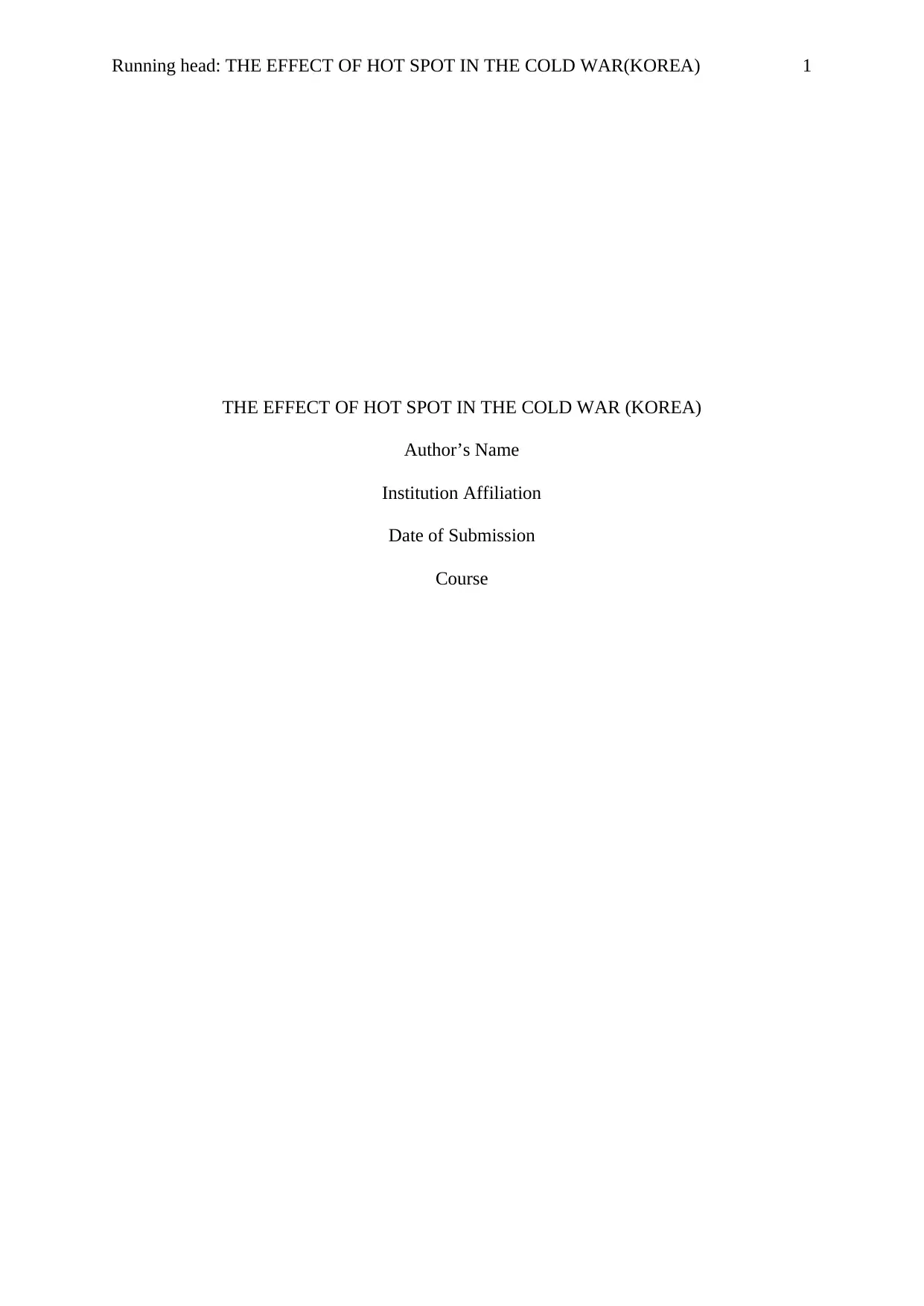
Running head: THE EFFECT OF HOT SPOT IN THE COLD WAR(KOREA) 1
THE EFFECT OF HOT SPOT IN THE COLD WAR (KOREA)
Author’s Name
Institution Affiliation
Date of Submission
Course
THE EFFECT OF HOT SPOT IN THE COLD WAR (KOREA)
Author’s Name
Institution Affiliation
Date of Submission
Course
Paraphrase This Document
Need a fresh take? Get an instant paraphrase of this document with our AI Paraphraser
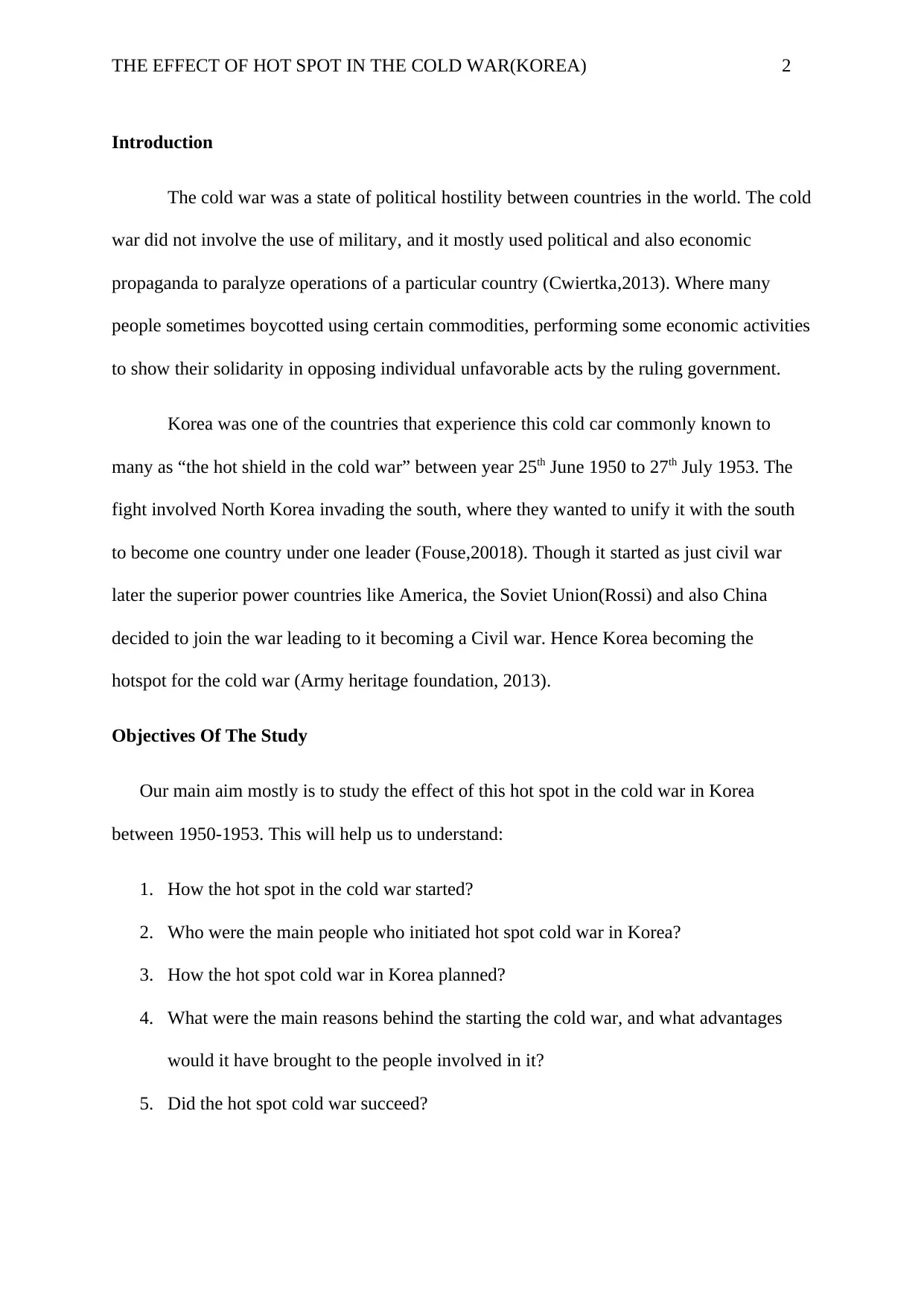
THE EFFECT OF HOT SPOT IN THE COLD WAR(KOREA) 2
Introduction
The cold war was a state of political hostility between countries in the world. The cold
war did not involve the use of military, and it mostly used political and also economic
propaganda to paralyze operations of a particular country (Cwiertka,2013). Where many
people sometimes boycotted using certain commodities, performing some economic activities
to show their solidarity in opposing individual unfavorable acts by the ruling government.
Korea was one of the countries that experience this cold car commonly known to
many as “the hot shield in the cold war” between year 25th June 1950 to 27th July 1953. The
fight involved North Korea invading the south, where they wanted to unify it with the south
to become one country under one leader (Fouse,20018). Though it started as just civil war
later the superior power countries like America, the Soviet Union(Rossi) and also China
decided to join the war leading to it becoming a Civil war. Hence Korea becoming the
hotspot for the cold war (Army heritage foundation, 2013).
Objectives Of The Study
Our main aim mostly is to study the effect of this hot spot in the cold war in Korea
between 1950-1953. This will help us to understand:
1. How the hot spot in the cold war started?
2. Who were the main people who initiated hot spot cold war in Korea?
3. How the hot spot cold war in Korea planned?
4. What were the main reasons behind the starting the cold war, and what advantages
would it have brought to the people involved in it?
5. Did the hot spot cold war succeed?
Introduction
The cold war was a state of political hostility between countries in the world. The cold
war did not involve the use of military, and it mostly used political and also economic
propaganda to paralyze operations of a particular country (Cwiertka,2013). Where many
people sometimes boycotted using certain commodities, performing some economic activities
to show their solidarity in opposing individual unfavorable acts by the ruling government.
Korea was one of the countries that experience this cold car commonly known to
many as “the hot shield in the cold war” between year 25th June 1950 to 27th July 1953. The
fight involved North Korea invading the south, where they wanted to unify it with the south
to become one country under one leader (Fouse,20018). Though it started as just civil war
later the superior power countries like America, the Soviet Union(Rossi) and also China
decided to join the war leading to it becoming a Civil war. Hence Korea becoming the
hotspot for the cold war (Army heritage foundation, 2013).
Objectives Of The Study
Our main aim mostly is to study the effect of this hot spot in the cold war in Korea
between 1950-1953. This will help us to understand:
1. How the hot spot in the cold war started?
2. Who were the main people who initiated hot spot cold war in Korea?
3. How the hot spot cold war in Korea planned?
4. What were the main reasons behind the starting the cold war, and what advantages
would it have brought to the people involved in it?
5. Did the hot spot cold war succeed?
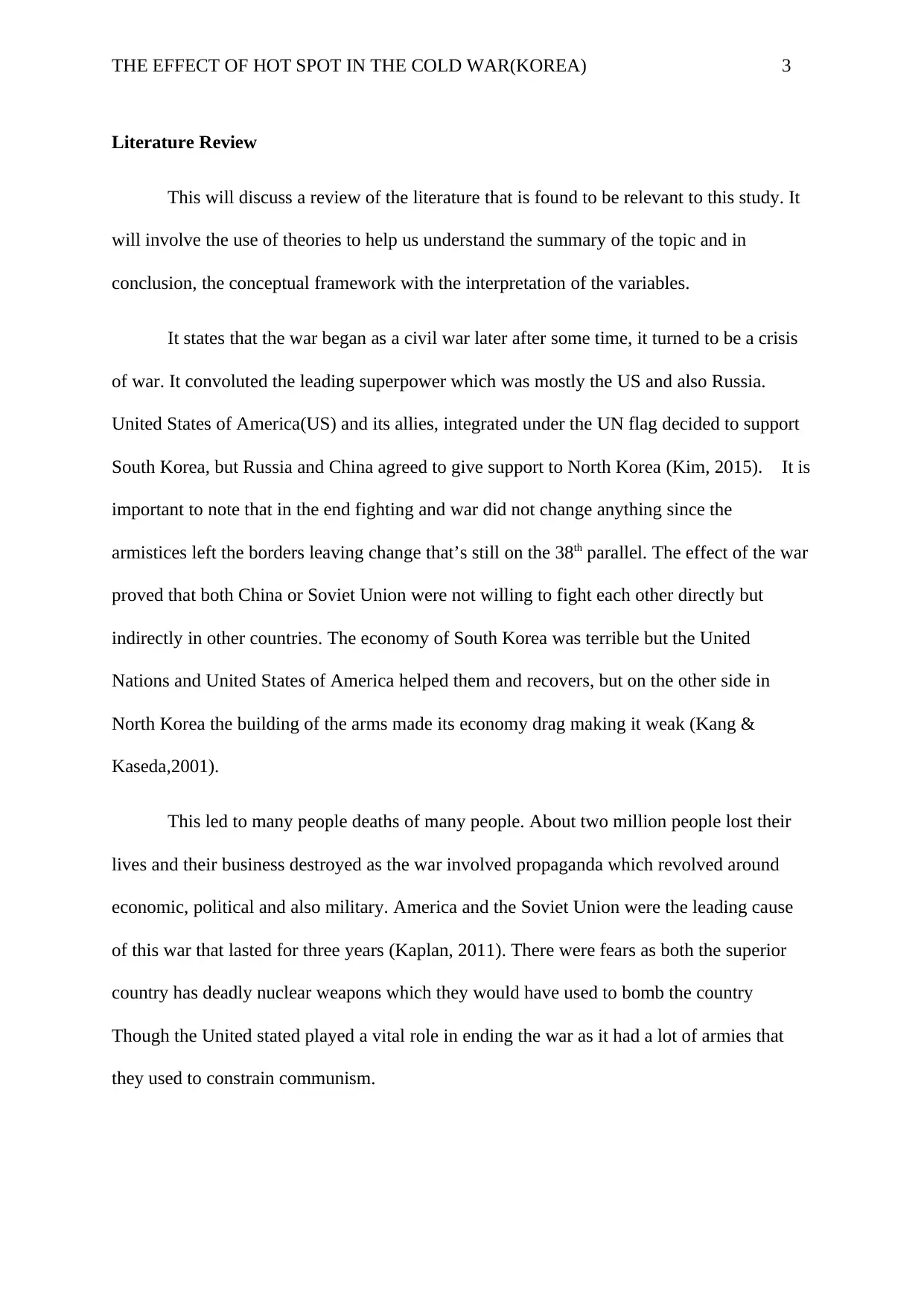
THE EFFECT OF HOT SPOT IN THE COLD WAR(KOREA) 3
Literature Review
This will discuss a review of the literature that is found to be relevant to this study. It
will involve the use of theories to help us understand the summary of the topic and in
conclusion, the conceptual framework with the interpretation of the variables.
It states that the war began as a civil war later after some time, it turned to be a crisis
of war. It convoluted the leading superpower which was mostly the US and also Russia.
United States of America(US) and its allies, integrated under the UN flag decided to support
South Korea, but Russia and China agreed to give support to North Korea (Kim, 2015). It is
important to note that in the end fighting and war did not change anything since the
armistices left the borders leaving change that’s still on the 38th parallel. The effect of the war
proved that both China or Soviet Union were not willing to fight each other directly but
indirectly in other countries. The economy of South Korea was terrible but the United
Nations and United States of America helped them and recovers, but on the other side in
North Korea the building of the arms made its economy drag making it weak (Kang &
Kaseda,2001).
This led to many people deaths of many people. About two million people lost their
lives and their business destroyed as the war involved propaganda which revolved around
economic, political and also military. America and the Soviet Union were the leading cause
of this war that lasted for three years (Kaplan, 2011). There were fears as both the superior
country has deadly nuclear weapons which they would have used to bomb the country
Though the United stated played a vital role in ending the war as it had a lot of armies that
they used to constrain communism.
Literature Review
This will discuss a review of the literature that is found to be relevant to this study. It
will involve the use of theories to help us understand the summary of the topic and in
conclusion, the conceptual framework with the interpretation of the variables.
It states that the war began as a civil war later after some time, it turned to be a crisis
of war. It convoluted the leading superpower which was mostly the US and also Russia.
United States of America(US) and its allies, integrated under the UN flag decided to support
South Korea, but Russia and China agreed to give support to North Korea (Kim, 2015). It is
important to note that in the end fighting and war did not change anything since the
armistices left the borders leaving change that’s still on the 38th parallel. The effect of the war
proved that both China or Soviet Union were not willing to fight each other directly but
indirectly in other countries. The economy of South Korea was terrible but the United
Nations and United States of America helped them and recovers, but on the other side in
North Korea the building of the arms made its economy drag making it weak (Kang &
Kaseda,2001).
This led to many people deaths of many people. About two million people lost their
lives and their business destroyed as the war involved propaganda which revolved around
economic, political and also military. America and the Soviet Union were the leading cause
of this war that lasted for three years (Kaplan, 2011). There were fears as both the superior
country has deadly nuclear weapons which they would have used to bomb the country
Though the United stated played a vital role in ending the war as it had a lot of armies that
they used to constrain communism.
⊘ This is a preview!⊘
Do you want full access?
Subscribe today to unlock all pages.

Trusted by 1+ million students worldwide
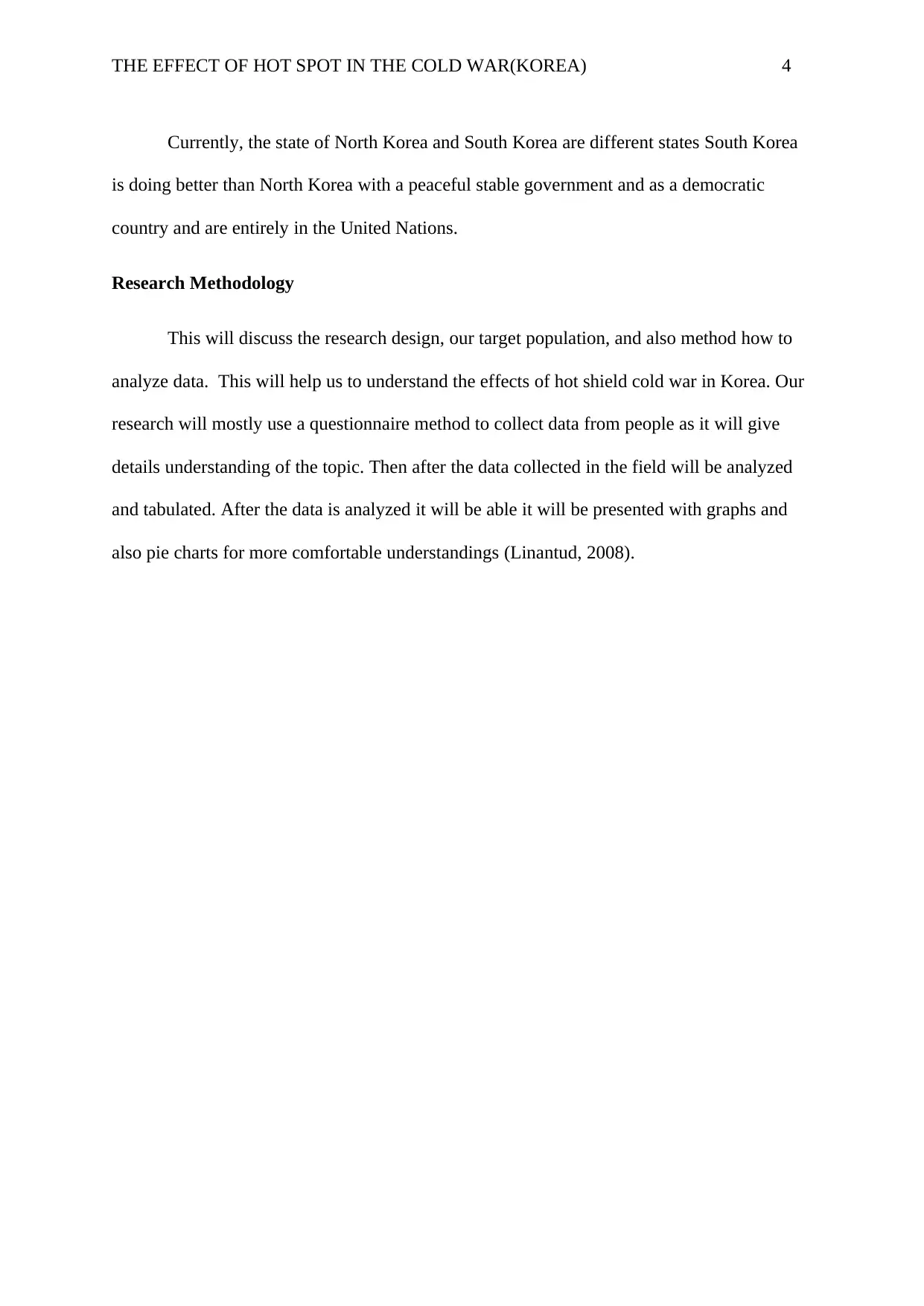
THE EFFECT OF HOT SPOT IN THE COLD WAR(KOREA) 4
Currently, the state of North Korea and South Korea are different states South Korea
is doing better than North Korea with a peaceful stable government and as a democratic
country and are entirely in the United Nations.
Research Methodology
This will discuss the research design, our target population, and also method how to
analyze data. This will help us to understand the effects of hot shield cold war in Korea. Our
research will mostly use a questionnaire method to collect data from people as it will give
details understanding of the topic. Then after the data collected in the field will be analyzed
and tabulated. After the data is analyzed it will be able it will be presented with graphs and
also pie charts for more comfortable understandings (Linantud, 2008).
Currently, the state of North Korea and South Korea are different states South Korea
is doing better than North Korea with a peaceful stable government and as a democratic
country and are entirely in the United Nations.
Research Methodology
This will discuss the research design, our target population, and also method how to
analyze data. This will help us to understand the effects of hot shield cold war in Korea. Our
research will mostly use a questionnaire method to collect data from people as it will give
details understanding of the topic. Then after the data collected in the field will be analyzed
and tabulated. After the data is analyzed it will be able it will be presented with graphs and
also pie charts for more comfortable understandings (Linantud, 2008).
Paraphrase This Document
Need a fresh take? Get an instant paraphrase of this document with our AI Paraphraser
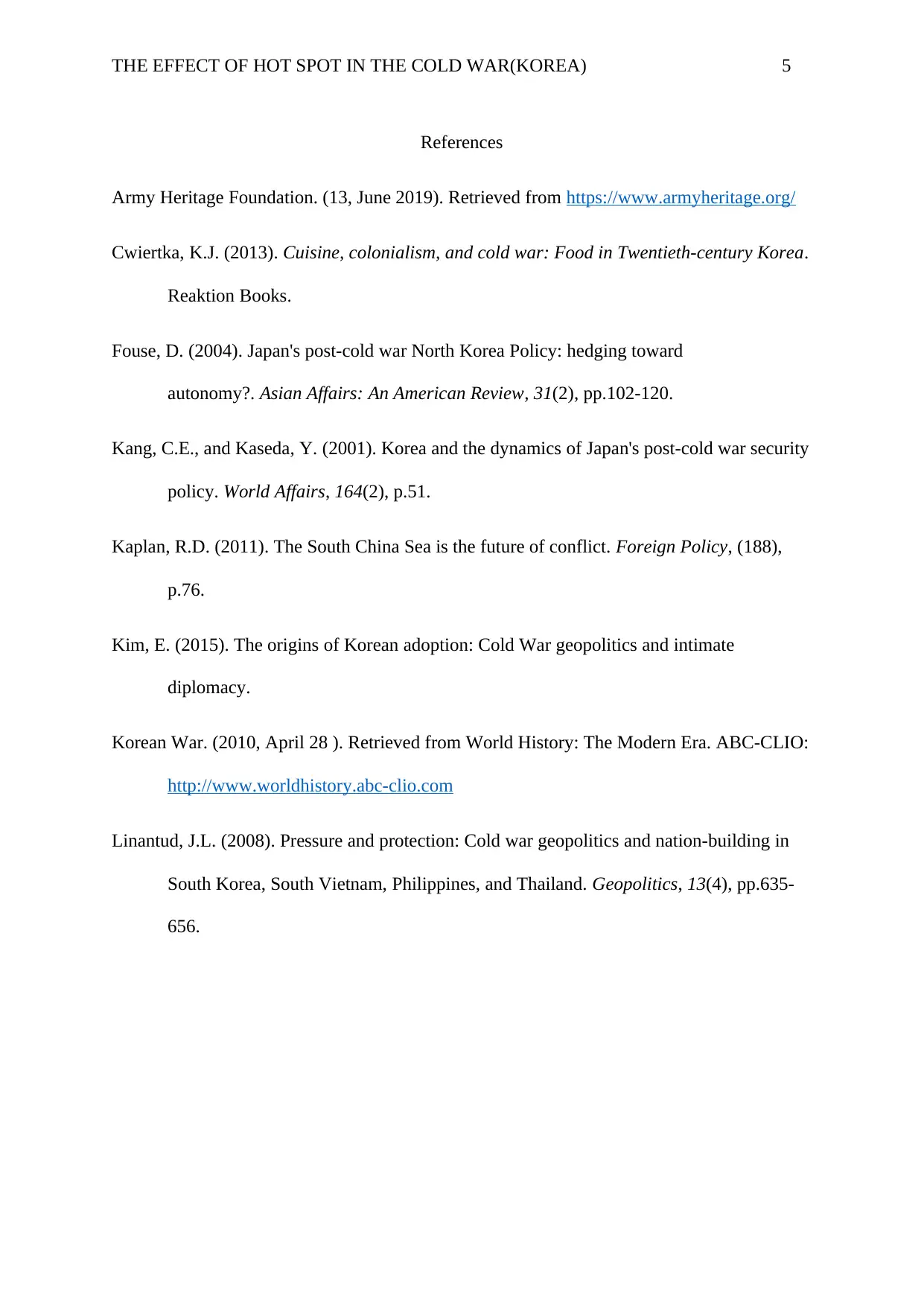
THE EFFECT OF HOT SPOT IN THE COLD WAR(KOREA) 5
References
Army Heritage Foundation. (13, June 2019). Retrieved from https://www.armyheritage.org/
Cwiertka, K.J. (2013). Cuisine, colonialism, and cold war: Food in Twentieth-century Korea.
Reaktion Books.
Fouse, D. (2004). Japan's post-cold war North Korea Policy: hedging toward
autonomy?. Asian Affairs: An American Review, 31(2), pp.102-120.
Kang, C.E., and Kaseda, Y. (2001). Korea and the dynamics of Japan's post-cold war security
policy. World Affairs, 164(2), p.51.
Kaplan, R.D. (2011). The South China Sea is the future of conflict. Foreign Policy, (188),
p.76.
Kim, E. (2015). The origins of Korean adoption: Cold War geopolitics and intimate
diplomacy.
Korean War. (2010, April 28 ). Retrieved from World History: The Modern Era. ABC-CLIO:
http://www.worldhistory.abc-clio.com
Linantud, J.L. (2008). Pressure and protection: Cold war geopolitics and nation-building in
South Korea, South Vietnam, Philippines, and Thailand. Geopolitics, 13(4), pp.635-
656.
References
Army Heritage Foundation. (13, June 2019). Retrieved from https://www.armyheritage.org/
Cwiertka, K.J. (2013). Cuisine, colonialism, and cold war: Food in Twentieth-century Korea.
Reaktion Books.
Fouse, D. (2004). Japan's post-cold war North Korea Policy: hedging toward
autonomy?. Asian Affairs: An American Review, 31(2), pp.102-120.
Kang, C.E., and Kaseda, Y. (2001). Korea and the dynamics of Japan's post-cold war security
policy. World Affairs, 164(2), p.51.
Kaplan, R.D. (2011). The South China Sea is the future of conflict. Foreign Policy, (188),
p.76.
Kim, E. (2015). The origins of Korean adoption: Cold War geopolitics and intimate
diplomacy.
Korean War. (2010, April 28 ). Retrieved from World History: The Modern Era. ABC-CLIO:
http://www.worldhistory.abc-clio.com
Linantud, J.L. (2008). Pressure and protection: Cold war geopolitics and nation-building in
South Korea, South Vietnam, Philippines, and Thailand. Geopolitics, 13(4), pp.635-
656.
1 out of 5
Related Documents
Your All-in-One AI-Powered Toolkit for Academic Success.
+13062052269
info@desklib.com
Available 24*7 on WhatsApp / Email
![[object Object]](/_next/static/media/star-bottom.7253800d.svg)
Unlock your academic potential
Copyright © 2020–2025 A2Z Services. All Rights Reserved. Developed and managed by ZUCOL.





